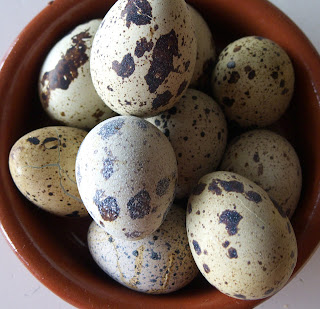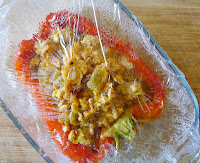 |
| Desayuno molinero--breakfast at an olive mill--perfect for brunch or lunch. |
As I was picking olives this week, my mind wandered, remembering olive picking in Jaén and a fabulous desayuno molinero—olive millers’ breakfast—that I enjoyed at an olive mill. What a spread! Toasted bread with new olive oil. Bowls of herb-flavored olives. Sliced ham and cold cuts. Fresh goat’s cheese and aged cheese in olive oil. Sliced tomatoes and sliced oranges, both bathed in green-gold oil.
The desayuno molinero once was a working-man’s breakfast in the mills, where work went on seven days a week during the season (usually October until January). Bread toasted on a wood fire and oil drawn off from the settling tanks were the basis, with other foods contributed to the potluck breakfast by the workers. In more recent times, the breakfast has became a more festive get-together, marking the opening or closing of the milling season, a saint´s day (milling continues even during holidays) or the arrival of buyers for an oil tasting. With the growth of oleo-turismo, tour groups also arrive at oil cooperatives for the typical breakfast spread.
A desayuno molinero makes a fine Sunday brunch or buffet lunch. It can be totally simple—toast, olive oil, deli cold cuts and cheese—or sumptuous with, for example, a whole ibérico ham, several kinds of cheeses, a selection of extra virgin oils, cold and hot dishes.
If it’s breakfast, you need coffee. In bygone times, the millers made café de puchero. (Bring water to a boil in a metal or earthenware cookpot. Remove from heat and add freshly ground coffee. Cover the pot and infuse the coffee three minutes. Pour the coffee through a cloth strainer into a jug to serve.) The coffee was often served in ceramic bowls rather than cups, with heated goat’s milk or, when fresh milk was not available, canned sweetened condensed milk. I have seen country folk douse bread with olive oil and break the bread into the milky, sweetened coffee creating a sort of breakfast porridge.
Breakfast in an Andalusian olive mill also means local wine—perhaps Montilla-Moriles from Córdoba or Málaga moscatel seco. Real campesinos might also take a copa of aguardiente, anise brandy, para matar el gusanillo, to kill the little “worm” of hunger that gnaws the insides.
Bread might be thick slices of a round country loaf (pan cateto), assorted crusty rolls (bollos) or soft buns (molletes). Toasted or not, the bread is generously spread with olive oil. Surprisingly, toast “buttered” with oil is really good with orange marmalade or any fruit jam. If you prefer savory, rub the toast with a cut clove of garlic before sprinkling on the oil. Top it with sliced tomatoes and cheese, ham or sausage.
Be sure to include oranges. Sprinkled with olive oil, oranges are special. They can be finished with onions, olives and shredded cod for a sort of salad or sprinkled with brown sugar or honey for a sweet.
Cooked dishes might include a potato tortilla or, as described by Mort Rosenblum in Olives—The Life and Lore of a Noble Fruit, huevos a la mala educación, or “ineptly done eggs,” fried in, of course, olive oil and broken into pieces. Or, even migas, bread crumbs fried in oil with bits of sausage, salt pork and garlic.
.
 |
| These are new-batch brine-cured olives, DOP (denominación de origen protegida) Aceitunas Aloreña de Málaga, purchased locally. My own olives have only begun the curing process. |
 |
| Shredded cod adds a salty contrast to sliced oranges with onions and olives, all dressed with extra virgin olive oil. |
 |
| Sliced oranges with olive oil are also good sprinkled with brown sugar or honey. |
 |
| Tomatoes and olive oil, the perfect pairing. Heap them on bread or mix with cheese to create a salad. |
 |
| Hard-boiled quails' eggs. Other egg dishes such as tortilla, revuelto or fried eggs and potatoes could be served at the brunch. |
 |
| Fresh goat's cheese is good drizzled with oil and sprinkled with herbs or, as dessert, served with honey, quince jam, or fresh fruit. |
Salad of Oranges, Olives and Cod
Ensalada de Naranjas con Aceitunas y Bacalao
Sliced oranges
Sliced onions or scallions
Salt-cured green olives
Shredded cod (desalted and cooked)
Extra virgin olive oil
Sherry vinegar
Arrange sliced oranges on a serving plate. Add onions and olives. Scatter the cod over the oranges. Sprinkle the oranges generously with oil and a few drops of vinegar.
More recipes for an Andalusian brunch:
Olives to oil at a small olive mill, here.



































